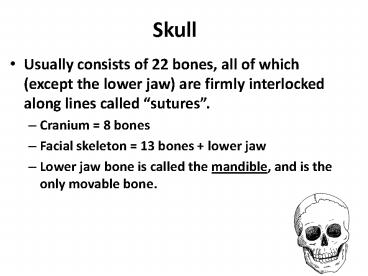Skull - PowerPoint PPT Presentation
Title: Skull
1
Skull
- Usually consists of 22 bones, all of which
(except the lower jaw) are firmly interlocked
along lines called sutures. - Cranium 8 bones
- Facial skeleton 13 bones lower jaw
- Lower jaw bone is called the mandible, and is the
only movable bone.
2
Cranium
- Functions
- Encloses and protects the brain
- Provides attachments for muscles that make
chewing and head movement possible - Has air-filled, mucous-membrane-lined (??), sinus
cavities
3
Cranial Bones
- Frontal bone
- Parietal bones (2)
- Occipital bone
- Temporal bones (2)
- Sphenoid bone
- Ethmoid bone
4
Cranial Bones, continued..
- Frontal bone
- Anterior portion of skull above the eyes
- Houses 2 frontal sinuses, one above each eye near
the midline - Parietal bones
- One on each side of the skull just behind the
frontal bone - Form bulging sides and roof of cranium
- Fused at midline (sagittal suture) and to frontal
bone (coronal suture)
5
Cranial Bones, continued..
- Occipital bone
- Joins the parietal bones (lambdoidal suture)
- Forms back of skull and base of cranium
- Foramen magnum opening at bottom of occipital
bone for nerve processes to connect to spinal
cord - Occipital condyles rounded processes on each
side of foramen magnum that articulate with 1st
vertebra
6
Cranial Bones, continued..
- Temporal bones
- On each side of the skull
- Joins parietal bone (squamosal suture)
- Form parts of sides and base of cranium
- External auditory meatus (???)
- Mandibular fossae depressions in the temporal
bone that articulate with condyles (???) of the
mandible
7
Cranial Bones, continued..
- Temporal bones, continued.
- Below each external auditory meatus
- Mastoid process rounded attachment for certain
neck muscles - Styloid process long, pointed anchor for
muscles associated with tongue and pharynx - Zygomatic process
- Projects anteriorly (???) from temporal bone,
joins the zygomatic bone (cheek bone), and
helps form prominence of the cheek
8
Cranial Bones, continued..
- Sphenoid bone
- Wedged between several other bones in anterior
portion of cranium - Has a central portion and 2 wing-like structures
that extend laterally (???) - Helps form base of cranium, sides of skull, and
sides of orbits (eye sockets) - Midline of sphenoid bone has a depression (sella
turcica) that houses pituitary gland - Contains 2 sphenoidal sinuses
9
Cranial Bones, continued..
- Ethmoid bone
- Located in front of sphenoid bone
- Consists of 2 masses, one on each side of nasal
cavity - Masses joined by thin cribriform plates (???)
- Cribriform plates form part of nasal cavity roof.
- Crista galli triangular process between
cribriform plates - Perpendicular plate
- projects downward from cribriform plates
- helps form nasal septum
10
Cranial Bones, continued..
- Ethmoid bone, continued..
- Superior nasal concha and middle nasal concha -
project inward from lateral portions of ethmoid
bone toward perpendicular plate - Lateral portions of ethmoid bone contain small
air spaces (ethmoidal sinuses)
11
Facial Skeleton
- Maxillae (2)
- Form the upper jaw
- Portions comprise the anterior (???) roof of the
mouth (hard palate), the floors of the orbits
(???), and the sides and floor of the nasal
cavity. - Contain sockets of the upper teeth
- Maxillary sinuses
- Inside the maxillae, lateral (???) to nasal
cavity - The largest of the sinuses
12
Facial Bones, continued.
- Maxillae, continued.
- Palatine processes fuse midline (???) to form
anterior section of hard palate - Teeth are found in cavities in the alveolar
arch (aka dental arch) formed by the alveolar
processes projecting downward from the inferior
(???) border of the maxillae.
13
Facial Bones, continued.
- Palatine bones
- Behind the maxillae
- Horizontal portions form posterior (???) section
of hard palate and floor of nasal cavity - Perpendicular portions help form lateral (???)
walls of nasal cavity
14
Facial Bones, continued..
- Zygomatic bones (???)
- Also help form lateral walls and floors of the
orbits - Each bone has a temporal process that connects
to the zygomatic process (forming the zygomatic
arch). - Lacrimal bones
- Thin, scale-like structure in medial wall (??) of
each orbit between ethmoid bone and maxilla
15
Facial Bones, continued..
- Nasal bones
- Long, thin, and nearly rectangular
- Lie side by side and fused at midline to form
bridge of nose - Vomer bone
- Thin and flat
- Along midline in nasal cavity
- Joins perpendicular plate of ethmoid bone
posteriorly (???) to form nasal septum
16
Facial Bones, continued..
- Inferior nasal conchae
- Fragile, scroll-shaped bones attached to lateral
walls (???) of nasal cavity - Support mucous membranes in nasal cavity
- Mandible (???)
- Upward projection at ends
- Posterior mandibular condyle articulates with
mandibular fossae on _______ bone - Anterior coronoid process provides attachments
for muscles for chewing - Alveolar arch curved, superior (???) border
that contains sockets for lower teeth











![Download Book [PDF] Skull Journal PowerPoint PPT Presentation](https://s3.amazonaws.com/images.powershow.com/10077045.th0.jpg?_=20240711124)
![Download Book [PDF] Skull Journal PowerPoint PPT Presentation](https://s3.amazonaws.com/images.powershow.com/10073920.th0.jpg?_=20240706124)


















